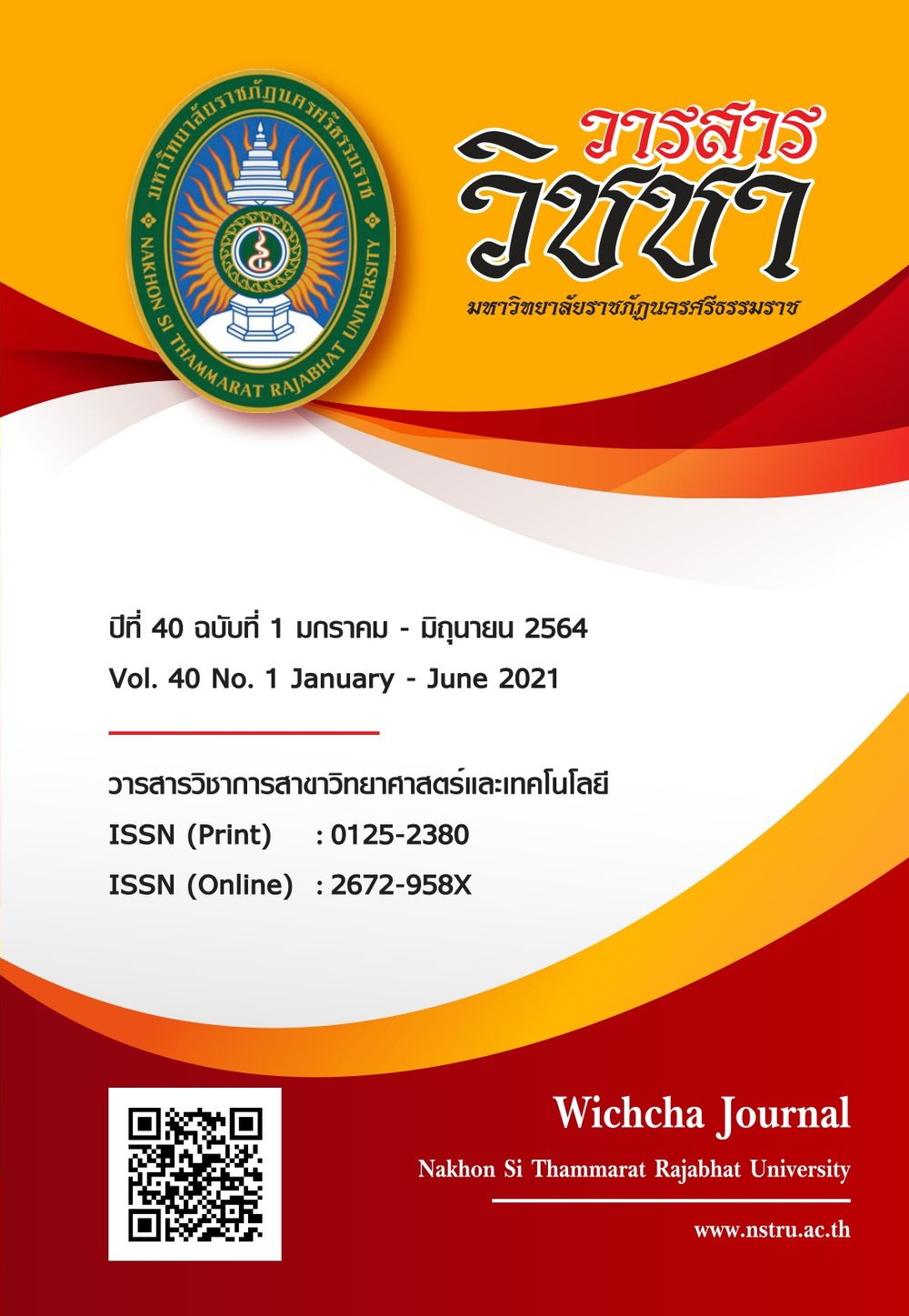Development of Longkong Syrup Processing การพัฒนากระบวนการผลิตไซรัปจากลองกอง
Main Article Content
Abstract
This research focused on the development of Longkong syrup processing. Lonkong syrup can be used as a natural sweetener with unique Longkong sweet tastes and flavors. The objective of this research was 1) to study the effect of pretreatments using the Sous-vide technique on the resulting Longkong juice appearance, 2) to study the effect of pectinase concentrations, incubation temperatures and times on % yield of Longkong juice extraction and 3) to study the change of Longkong syrup during storage. The results revealed that using the Sous-vide technique at 90 oC for 15 min was appropriate for preparing Longkong juice to inhibit enzymatic browning reaction when compared to without heating and control samples. Then, an appropriate condition to extract Longkong juice was analyzed by using Box-Behnken design. The pectinase concentrations (X1), incubation temperatures (X2) and times (X3) were used as factors to perform. The condition of 0.75% pectinase, incubation at 40 oC for 180 min was obtained with the highest yield of 89.5-91.0%. Subsequently, Longkong juice was evaporated by using a vacuum dryer at 50 oC till a total soluble solid of 65 ˚Brix. Longkong syrup was stored at room temperature for 45 days. The results showed that Longkong syrup was darker and the total color difference overall (∆E) was 92.54 when compared to the color value of the initial Longkong syrup. Moreover, the moisture content of Longkong syrup increased from 29.72% to 41.99% but there was no change in pH, total microbial count and yeast and mold count.
Article Details
เนื้อหาและข้อมูลในบทความที่ลงตีพิมพ์ในวารสารวิชชา มหาวิทยาลัยราชภัฏนครศรีธรรมราช ถือเป็นข้อคิดเห็นและความรับผิดชอบของผู้เขียนบทความโดยตรง ซึ่งกองบรรณาธิการวารสารไม่จำเป็นต้องเห็นด้วยหรือร่วมรับผิดชอบใด ๆ
บทความ ข้อมูล เนื้อหา รูปภาพ ฯลฯ ที่ได้รับการตีพิมพ์ในวารสารวิชชา มหาวิทยาลัยราชภัฏนครศรีธรรมราช ถือเป็นลิขสิทธ์ของวารสารวิชชา มหาวิทยาลัยราชภัฏนครศรีธรรมราช หากบุคคลหรือหน่วยงานใดต้องการนำข้อมูลทั้งหมดหรือส่วนหนึ่งส่วนใดไปเผยแพร่ต่อหรือเพื่อการกระทำการใด ๆ จะต้องได้รับอนุญาตเป็นลายลักษณ์อักษรจากวารสารวิชชา มหาวิทยาลัยราชภัฏนครศรีธรรมราชก่อนเท่านั้น
The content and information in the article published in Wichcha journal Nakhon Si Thammarat Rajabhat University, It is the opinion and responsibility of the author of the article. The editorial journals do not need to agree. Or share any responsibility.
References
กรมส่งเสริมการเกษตร. (2563). หนังสือการจัดชั้นคุณภาพของผลไม้ (ทุเรียน มังคุด เงาะ ลองกอง ลำไย และลิ้นจี่). สืบค้นเมื่อวันที่ 11 กุมภาพันธ์ 2564, จาก: https://esc.doae.go.th/wp-content/uploads/2020/08/%E0%B8%AB%E0%B8%99%E0%B8%B1%E0%B8%87%E0%B8%AA%E0%B8%B7%E0%B8%AD%E0%B8%81%E0%B8%B2%E0%B8%A3%E0%B8%88%E0%B8%B1%E0%B8%94%E0%B8%8A%E0%B8%B1%E0%B9%89%E0%B8%99%E0%B8%84%E0%B8%B8%E0%B8%93%E0%B8%A0%E0%B8%B2%E0%B8%9E%E0%B8%9C%E0%B8%A5%E0%B9%84%E0%B8%A1%E0%B9%89.pdf.
ธิดารัตน์ จุทอง รัทรดา สมพงษ์ และอุราภรณ์ เรืองวัชรินทร์. (2560). การพัฒนาผลิตภัณฑ์ลองกองแผ่นอบแห้งเสริม Lactobacillus casei TISTR 1463 ที่ห่อหุ้มด้วยอัลจิเนตด้วยวิธีเอนแคปซูเลชัน. วารสารวิชาการวิทยาศาสตร์และเทคโนโลยี มหาวิทยาลัยราชภัฎนครสวรรค์, 9(9), 63-72.
นิธิยา รัตนาปนนท์. (2545). เคมีอาหาร. กรุงเทพฯ: สำนักพิมพ์โอเดียนสโตร์.
มะลิวัลย์ ไชยโย. (2554). การเปรียบเทียบคุณภาพของไซรัปกล้วยที่ผลิตจากน้ำตาลทรายและน้ำอ้อย. สารนิพนธ์วิทยาศาสตรศึกษามหาบัณฑิต. มหาวิทยาลัยศรีนครินทรวิโรฒ, กรุงเทพฯ.
วาสนา พิทักษ์พล ศศิธร สวยสม และหทัยทิพย์ นิมิตรเกียรติไกล. (2557). ผลของเมทิลจัสโมเนตและไคโทซานต่อคุณภาพหลังการเก็บเกี่ยวของผลลองกอง. แก่นเกษตร, 42(ฉบับพิเศษ), 589-595.
สถาบันวิจัยวิทยาศาสตร์และเทคโนโลยีแห่งประเทศไทย. (2558). ผลิตภัณฑ์แปรรูปลองกอง. สืบค้นเมื่อ 22 มิถุนายน 2564, จาก: http://waa.inter.nstda.or.th/stks/pub/2015/20150911-Technology-show%202-2558-Food-Beverage-10.pdf.
สำนักงานเศรษฐกิจการเกษตร. (2562). ลองกอง: เนื้อที่ยืนต้น เนื้อที่ให้ผล ผลผลิต และผลผลิตต่อไร่ ปี 2562. สืบค้นเมื่อ 11 กุมภาพันธ์ 2564, จาก: http://www.oae.go.th/assets/portals/1/fileups/prcaidata/files/longkong62(1).pdf.
Abbes, F., Masmoudi, M., Kchaou, W., Danthine, S., Blecker, C., Attia, H. and Besbes, S. (2015). Effect of enzymatic treatment on rheological properties, glass temperature transition and microstructure of date syrup. LWT-Food Science and Technology, 60(1), 339-345.
Ahdno, H. and Jafarizadeh-Malmiri, H. (2017). Development of a sequenced enzymatically pre-treatment and filter pre-coating process to clarify date syrup. Food and Bioproducts Processing, 101, 193-204.
Alsenaien, W.A.A., Alamer, R.A., Tang, Z.X., Albahrani, S.A.A., Al-Ghannam, M.A. and Aleid, S.M. (2015). Substitution of sugar with dates powder and date syrup in cookies making. Advance Journal of Food Science and Technology, 8(1), 8-13.
Baldwin, D.E. (2012). Sous-vide cooking: a review. International Journal of Gastronomy and Food Science, 1(1), 15-30.
Chairgulprasert, V., Krisornpornsan, B. and Hamad, A. (2006). Chemical constituents of the essential oil and organic acids from longkong (Aglaia dookkoo Griff.) fruits. Songklanakarin Journal of Science and Technology, 28(2), 321-326.
El-Sharnouby, G.A., Al-Eid, S.M. and Al-Otaibi, M.M. (2009). Utilization of enzymes in the production of liquid sugar from dates. African Journal of Biochemistry Research, 3(3), 041-047.
Farrokhi, F., Mizani, M. and Honarvar, M. (2012). Study of probable physicochemical changes during the storage of light and thick sucrose syrups. World Applied Sciences Journal, 18(5), 715-721.
Kuriakose, S.P., Krishman, A. and Rawson, A. (2016). Advantages and limitations of sous vide processing of vegetables. International Journal of Science, Environment, 5(4), 1964-1967.
Kumar, S. (2015). Role of enzymes in fruit juice processing and its quality enhancement. Advanced in Applied Science Research, 6(6), 114-124.
Nawawi, M.H., Mohammad, R., Tahir, P. and Saad, W.Z. (2017). Extracellular xylanopectinolytic enzymes by Bacillus subtilis ADI1 from EFB’s compost. International Scholarly Research Notices, doi: https://doi.org/10.1155/2017/7831954.
Phomkong, W., Wachum, M. and Inree, R. (2015). Quality Jackfruit syrup using different jackfruit varieties. Journal of Science and Technology, Ubon Ratchathani University, 17(2), 9-16.
Potter, N.N. and Hotchkiss, J.H. (1995). Food Science. (5th ed). New York: Chapman & Hall.
Sangkasanya, S. and Meenune, M. (2010). Physical, chemical and sensory quality of longkong (Aglaia dookkoo Griff.) as affected by storage at different atmospheres. Asian Journal of Food and Agro-Industry, 3(1), 64-74.
Solis-Fuentes, J.A., Ayala-Tirado, R.C. and Duran-de-Bazua, M.C. (2016). Thermal and storage stability of color in juice and fructose syrup sugar cane. Journal of Scientific and Industrial Research, 75(2), 82-88.
Surin, S., Thakeow, P., Seesuriyachan, P., Angeli, S. and Phimolsiripol, Y. (2014). Effect of extraction and concentration processes on properties of Longan syrup. Journal of Food Science and Technology, 5(19), 2062-2069.
Thakur, N.S., Thakur, N., Hamid, H. and Thakur, A. (2018). Studied on development and storage quality evaluation of vitamin C rich syrup prepared from wild aonla (Phyllanthus emblica L.) fruits. The Pharma Innovation Journal, 7(2), 167-172.
Tobolkova, B., Durec, J., Belajova, E., Mihalikova, M., Polovka, M., Suhaj, M., Dasko, L. and Simko, P. (2013). Effect of light conditions on physico-chemical properties of pineapple juice with addition of small pineapple pieces during storage. Journal of Food and Nutrition Research, 52(3), 181-190.
Tochi, B.N., Wang, Z., Xu, S.Y. and Zhang, W. (2009). The influence of a pectinase and pectinase/hemicellulases enzyme preparations on percentage pineapple juice recovery, particulates and sensory attributes. Pakistan Journal of Nutrition, 8(8), 1184-1189.
Venkatachalam, K. and Meenune, M. (2012). Physical and chemical quality changes of longkong (Aglaia dookkoo Griff.) during passive modified atmospheric storage. International Food Research Journal, 19(3), 795-800.
Zavadlav, S., Blaži´, M., Van de Velde, F., Vignatti, C., Fenoglio, C., Piagentini, A.M., Pirovani, M.E., Perotti, C.M., Kovacevic, D.B. and Putnik, P. (2020). Sous-vide as a technique for preparing healthy and high-quality vegetable and seafood products. Foods, 9(11), 1537, doi: https://doi.org/10.3390/foods9111537.


